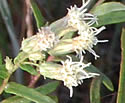Brickellia eupatorioides (False Boneset)
| Also known as: | |
|---|---|
| Genus: | Brickellia |
| Family: | Asteraceae (Aster) |
| Life cycle: | perennial |
| Origin: | native |
| Habitat: | sun; dry to average moisture; prairies, open woods, along railroads, bluffs |
| Bloom season: | August - September |
| Plant height: | 1 to 4 feet |
| Wetland Indicator Status: | none |
| MN county distribution (click map to enlarge): |  |
| National distribution (click map to enlarge): |  |
Pick an image for a larger view. See the glossary for icon descriptions.
Detailed Information
Flower: 

![[photo of flowers]](/udata/r9ndp23q/white/false-boneset_0824_142510-t.jpg) Branching clusters, sometimes a flat or round cluster at the top of the plant, or open and loose on branching stems. Flower heads are stalked, rayless (no petals) but have 15 to 30 disk flowers each with 5 tiny lobes and a forked, creamy white to pale yellow, thread-like style protruding from the center. The bracts are very narrow, flat to somewhat spreading, sometimes tinged purple at the tip, and form a cylinder nearly ½ inch long around the base of the flower head.
Branching clusters, sometimes a flat or round cluster at the top of the plant, or open and loose on branching stems. Flower heads are stalked, rayless (no petals) but have 15 to 30 disk flowers each with 5 tiny lobes and a forked, creamy white to pale yellow, thread-like style protruding from the center. The bracts are very narrow, flat to somewhat spreading, sometimes tinged purple at the tip, and form a cylinder nearly ½ inch long around the base of the flower head.
Leaves and stems: 


![[photo of leaves]](/udata/r9ndp23q/white/false-boneset_0814_125555-t.jpg) Leaves are 1 to 4 inches long and up to about 1 inch wide, toothless or with a few scattered coarse teeth, variously hairy, dotted with glands on the underside, tapering to a pointed tip, with a single prominent vein. Lower leaves are short stalked, becoming stalkless in the upper plant. Attachment is alternate but leaves may be densely packed and some may appear opposite. Stems are single or multiple from the base, densely covered in short fine hairs, initially green and often becoming reddish brown with age, and woody at the base.
Leaves are 1 to 4 inches long and up to about 1 inch wide, toothless or with a few scattered coarse teeth, variously hairy, dotted with glands on the underside, tapering to a pointed tip, with a single prominent vein. Lower leaves are short stalked, becoming stalkless in the upper plant. Attachment is alternate but leaves may be densely packed and some may appear opposite. Stems are single or multiple from the base, densely covered in short fine hairs, initially green and often becoming reddish brown with age, and woody at the base.
Fruit: 
![[photo of fruit]](/udata/r9ndp23q/pd/brickellia-eupatorioides-79877-t.jpg) Fruit is a dry seed with a tuft of dull white to light brown hairs to carry it off in the wind.
Fruit is a dry seed with a tuft of dull white to light brown hairs to carry it off in the wind.
Notes:
False Boneset (formerly Kuhnia eupatorioides) has a very long taproot, growing to 16 feet deep. While the flowers vaguely resemble those of Eupatorium species, the leaves of each species should readily tell them apart. Common Boneset (Eupatorium perfoliatum) has broader perfoliate leaves (opposite leaf pairs that join around the stem) and Tall Boneset (Eupatorium altissimum) has leaves with consistent toothing around the tip half, and 3 distinct parallel veins. There are up to 6 varieties of Brickellia eupatorioides in North America, with var. corymbulosa found in Minnesota and most of middle America.
Native Plant Nurseries, Restoration and Landscaping Services ↓
More photos
Photos by K. Chayka taken at Battle Creek Regional Park, Ramsey County, and Hastings Sand Coulee SNA, Dakota County. Photos courtesy Peter M. Dziuk taken in Dakota County.
Comments
Have you seen this plant in Minnesota, or have any other comments about it?
on: 2017-10-17 14:26:52
I think it is important to know that this species resembles Giant Goldenrod, especially during the fall when it is hard to differentiate the flower clusters. As a wetland delineator, this species has the potential to sway a decision.
on: 2017-10-17 15:06:22
Giant goldenrod would be hairless, where false boneset is variously hairy, and typically finely hairy all along the stem. While other goldenrod species might be hairy, the arrangement of the flower cluster branches and length of the involucres (set of bracts around a flower) should be a pretty consistent and measurable difference.
False boneset has a few stalked flowers with long involucres (to 15mm) at the tip of each branch where goldenrods have more numerous flowers all along a branch (often only on one side of the branch), the stalks are pretty short as are the involucres (less than 5mm). False boneset also has fairly long hairs on mature achenes where goldenrods are much shorter.
The general leaf shape might be similar across species but nothing in the flower clusters is very similar between false boneset and goldenrods. Even if the fruit has all dropped the branch arrangement should still be distinct. And false boneset is mostly found in upland sites so finding it near a wetland might be unusual to begin with.
on: 2020-12-05 15:18:47
Not thus far noted for Otter Tail County
on: 2020-12-05 15:37:07
Charles, I checked the Bell online atlas and you are right - no one has collected a specimen from Otter Tail County.
on: 2023-07-17 22:49:27
I saw this at Flandrau State Park today, on the grassland trail.







 False Boneset plants
False Boneset plants more plants
more plants falling down plant
falling down plant